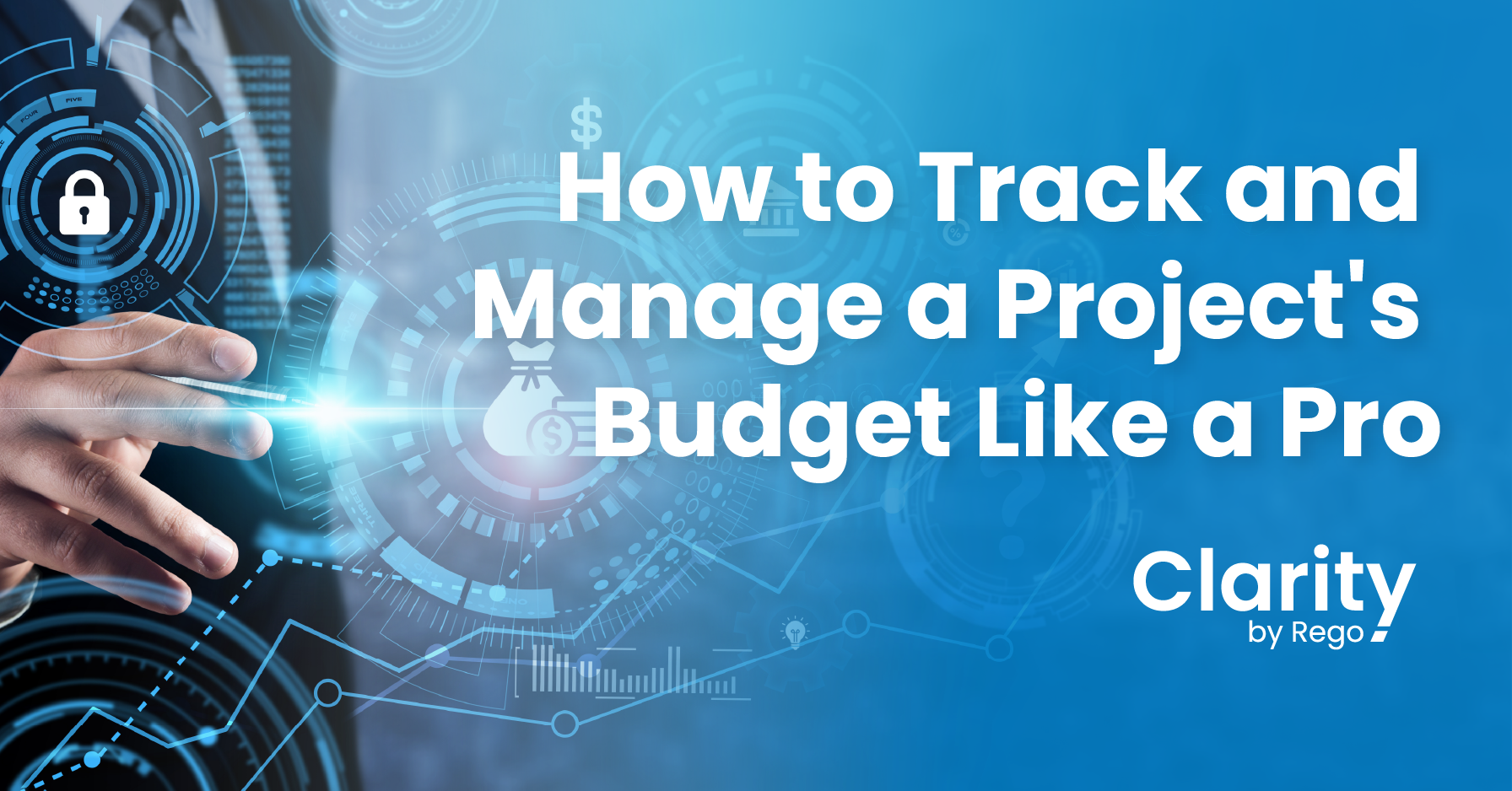by Clarity by Rego
Share
- How to Track and Manage a Project’s Budget Like a Pro
- Understanding Project Budget Management
- What Should a Project Budget Include?
- Aligning Your Budget with the Big Picture
- Keep Your Budget Healthy
- Key Aspects of Managing a Project Budget
- Budget Creation
- Budget Control
- Budget Adjustments
- Effective Project Budget Management Strategies
- Plan for Risks
- Use Smart Financial Reporting
- Communicate Clearly
- Make Data-Driven Decisions
- Bringing It All Together
- Get Notified of Updates.

Managing a project budget is more than watching dollars and cents. To have a successful project, you need to make sure every resource and decision is aligned with your goals from start to finish. A well-managed budget keeps your project on track, protects your timeline, and gives your team the confidence to deliver results without unpleasant financial surprises.
Project budget management means tracking costs, allocating resources wisely, and staying flexible when changes happen. It’s a skill that helps you stay in control instead of scrambling to explain where the money went.
When you stay on top of your budget:
According to a McKinsey & Company study, large IT projects typically exceed budgets by 45% on average and often deliver 56% less value than expected. With clear tracking and the right tools, you can keep your project’s finances healthy and deliver the results you promised.
Let’s break down the practical strategies and tools every project manager should know to keep budgets in check and projects running smoothly.
Understanding Project Budget Management
Project budget management is all about giving your team a clear financial blueprint for success. It’s the disciplined process of planning and keeping control of every dollar spent throughout the project’s lifecycle from kickoff to closeout. Done well, it keeps your spending aligned with your plan and your goals within reach.
A strong project budget empowers teams to compare actual expenses with what was planned, hold everyone accountable, and make informed decisions when things shift,
because in the real world, they always do. When your budget is well-managed, you’re far more likely to deliver your project within its approved funding and avoid last-minute scrambles for extra resources.
What Should a Project Budget Include?
Building a realistic budget plan starts with breaking costs down into the right categories. Direct costs — like labor, materials, and equipment — often make up the bulk of a budget. But indirect costs, like overhead and administrative expenses, can quietly eat into your funding if they’re not accounted for properly. Contingency funds help you cover surprises, and risk reserves give you a safety net for bigger unknowns.
Aligning Your Budget with the Big Picture
A budget plan on its own isn’t enough. It must match the full scope of work, your timeline and milestones, resource needs, and (most importantly!) stakeholder expectations. It should also support your broader business objectives, so everyone stays focused on the same end goal.
Keep Your Budget Healthy
Maintaining financial control takes discipline. The best project managers keep a close eye on budgets through regular reviews, clear communication, and detailed documentation of all costs. They don’t just track numbers; they understand where the money is going and why.
Standardized approval processes help avoid rogue spending, while change control procedures prevent unplanned expenses from derailing the bigger picture. Monitoring cost variances (the gap between planned and actual spending) allows you to catch problems early and adjust course before they snowball.
Modern project management tools make this much easier. Real-time tracking and reporting keep everyone in the loop and give you confidence that you’re steering your project in the right direction.
Key takeaway: A robust budget management system gives you the insight and flexibility to tackle challenges head-on, keeping your project financially healthy while delivering the value you promised.

Key Aspects of Managing a Project Budget
Every successful project budget stand on a few solid pillars: clear planning, real-time tracking, active cost control, and the ability to adapt when things don’t go as planned. Here’s how to put those pieces together in a way that works in the real world.
Budget Creation
Creating a realistic budget starts with what you know and what you’ve learned from the past. Look at similar projects to understand where money typically goes and where surprises pop up. Map out every resource you’ll need: people, equipment, materials, and any specialized contractors or suppliers.
Break big tasks down into smaller estimates, so nothing slips through the cracks. And always build in a buffer. A healthy contingency (usually 5–10% of the total budget) is your safety net for the unexpected.
Budget Control
Controlling your budget means staying proactive. Regular reviews help you see where costs might be creeping up. Make sure your team documents every change request and always weigh its financial impact before giving the green light.
A smart scope management process helps you avoid surprise overruns. When it comes to procurement, don’t just accept the first quote. Compare options, negotiate better rates, and keep a close eye on delivery dates, so you don’t get hit with rush fees later.
Budget Adjustments
Even the best budgets need to bend sometimes. Reallocating funds between categories, cutting non-essential costs, or phasing certain work can keep your project moving when things change.
If you truly need additional funding, build a clear case that shows exactly how the extra investment will deliver value. Decision-makers want to see ROI, not just a bigger bill.

Effective Project Budget Management Strategies
So how do you pull this all together day to day? It’s a mix of careful planning and clear communication.
Plan for Risks
Every project comes with uncertainties. Identify potential budget risks early and log them into a risk register. Estimate how likely each risk is, what impact it could have, and what reserves you’ll need to cover it. Schedule regular check-ins to review your risks and make sure your mitigation strategies still work.
Use Smart Financial Reporting
Good reporting makes it easier to spot trouble early. Set up dashboards that automatically show your planned vs. actual costs, budget burn rate, and any cost variance. Visuals help stakeholders grasp the big picture at a glance. No one wants to wade through a dense spreadsheet if they don’t have to.
Communicate Clearly
Don’t let budget updates get buried in jargon or stale slides. Tailor financial reports for different stakeholder groups. What your finance team needs is not the same as what your project sponsor wants to see. Schedule regular reviews to keep everyone in the loop, and make sure people know exactly who to go to when budget issues pop up.
Make Data-Driven Decisions
Numbers mean nothing if you don’t use them. Look at trends in your spending, analyze where variances come from, and compare your current performance to similar projects. Predictive insights can help you catch future budget issues before they arrive.
If you manage multiple projects, take a portfolio view: balance resources, spot opportunities for cost sharing, and standardize how you track budgets across teams.
Leverage the Right Tech
A modern PPM (Project Portfolio Management) platform like Clarity PPM can be a great ally. Integrate it with your financial systems so budget data flows in real time, not weeks later. Automate alerts when you’re nearing thresholds. Cloud-based tools keep everyone on the same page, whether they’re in the office or remote.

Bringing It All Together
A healthy project budget is a living, working plan that guides your decisions every day. The real difference between projects that stay on track and those that spiral out of control is how actively teams track, manage, and adjust when the unexpected happens.
When you know where your money is going, when you plan risks, and when your reporting makes sense to the people who need it, you’re in control — and your stakeholders know it. Add the right mix of tools and clear communication, and you’re not just watching the numbers; you’re using them to make smarter decisions at every stage.
So, whether you’re managing a small internal project or a large-scale initiative with hundreds of moving parts, make budget tracking and control your best friend. Protect your scope and keep your team and stakeholders informed every step of the way.
In the end, you deliver trust, value, and a clear return on every dollar spent, and that’s how you manage a project budget like a pro.
STAY IN THE LOOP
Get Notified of Updates.
Stay ahead of the curve by subscribing to our newsletter. Get the latest insights, strategies, and tools delivered straight to your inbox, and empower your business to achieve more.


